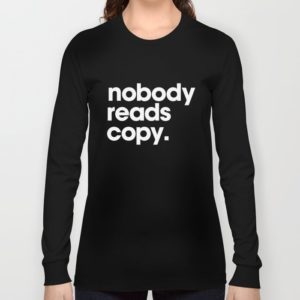
12 Mar The Problem (and Solution) with Trading Information for Action
At its most basic, advertising is the trading of INFORMATION for some specific ACTION. As we’ll see, this can be a problem, but also a solution.
EXAMPLE: Here’s some INFORMATION about our product, will you take the ACTION of purchasing this product?
Accurate but uninspiring.
What would happen if we drilled down on our formulation? Instead of INFORMATION and ACTION we went for PROBLEM and SOLUTION. Consider this better example.
BETTER EXAMPLE: Here’s some information about a PROBLEM you have, can we provide you with a SOLUTION in the form of our product?
Better, yes?
That’s because the second example applies the tenets of selling to the advertising construct. Focus on the individual, frame a problem in their life, give them the solution to it, and make it easy for them to say yes to this solution.
Boring Comes In All Sizes
This advice may sound obvious. But many companies are stuck in the mindset of the first example. They want to talk about their product rather than talking about the needs of the consumer. But then at some point, they come to recognize they’re producing an ad that nobody wants to read. So they start cutting copy. Overthinking the metrics. And panicking.
Now instead of a long ad nobody wants to read they’ve got a short ad that nobody wants to read.
 Of course they’re right about nobody wanting to read it part. The consumer doesn’t want to read about some random product (or even skim bullet points).
Of course they’re right about nobody wanting to read it part. The consumer doesn’t want to read about some random product (or even skim bullet points).
What they do want to read about is a solution to their own problems, and how your product can solve them. When companies approach apply a problem solution approach to their messaging, concerns about copy length seem to dissipate because the messaging is so relevant.
There Are No Bad Products. Only Bad Commercials.
Recently my daughter asked me what I do for a living. I told her I do advertising. When this answer elicited a blank stare, I simplified it to, “I make commercials.” Obviously this resonated with her because she grew concerned and said, “But Daddy, commercials are bad.”
Her comment was less about the socioeconomic value of the profession and more about the abundance of bad commercials she hears me complaining about. Because most commercials are simply hawking goods. They’re pompous, they’re self-absorbed and they’re ineffective.
The truly good commercials are rarely selling anything. They’re problem solving. They’re advocating for the other consumer who will benefit from having their product.
The Problem is the Solution
So what’s it all mean then? Well, it means advertising, like the gifted sales person, needs to be nuanced in its approach. It needs to confound expectations. It needs to be thought upon and obsessed over, yet whimsical and ubiquitous. Good advertising needs to be executed with the touch of a fine artist, delivered with the subtlety of a lead hammer, and analyzed with the eye of a scientist.
It will need to hold its direction while being subjected to an infinite number of social/ethical/and cultural cross currents. It needs to be able to comfort the afflicted and afflict the comforted and inspire the uninspired.
But most of all, it needs to identify PROBLEMS in potential customer’s situation where they exist and then present a SOLUTION.

